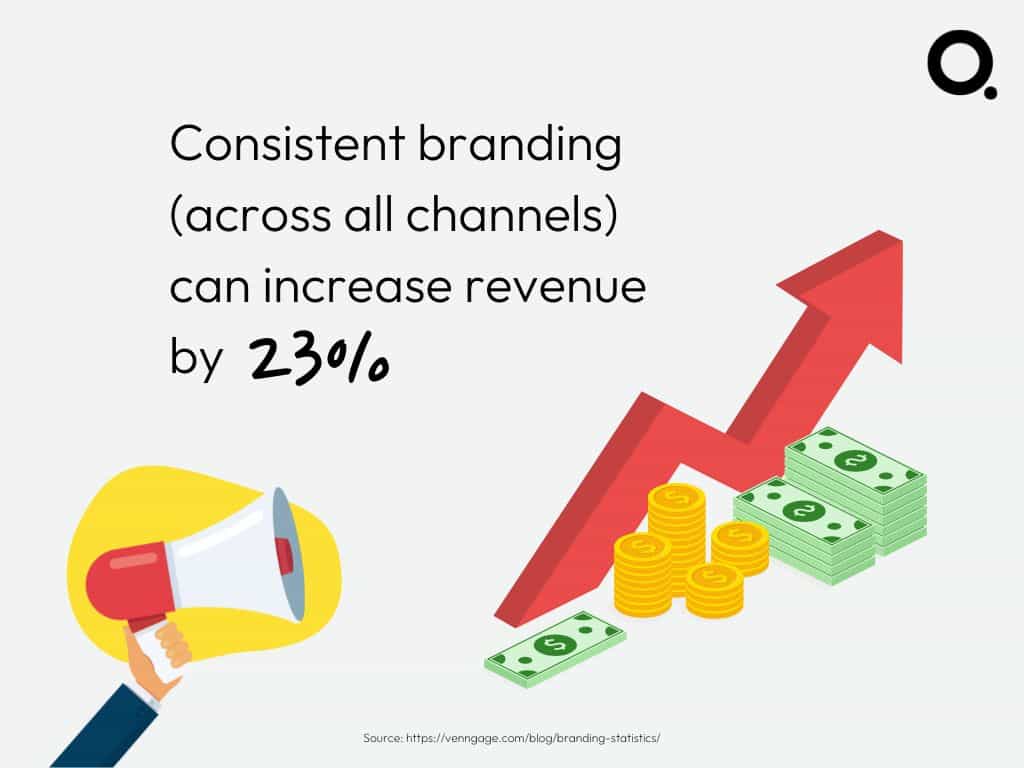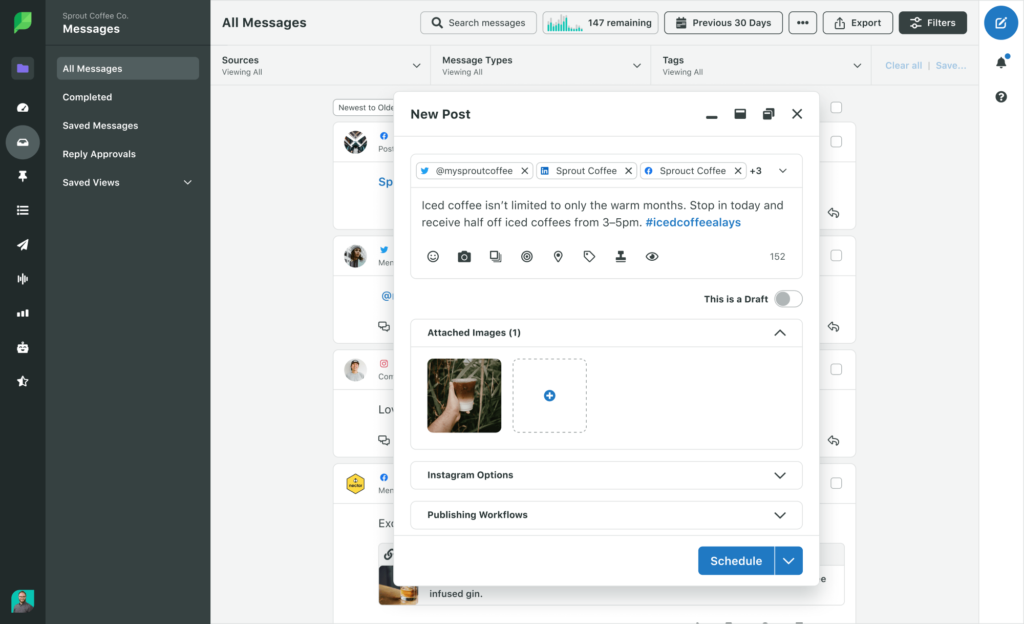Social media has outgrown itself. It’s not just for staying in touch with friends anymore. It’s the largest global media platform. And just like TV and radio before it, marketers have jumped aboard.
We use it for news, entertainment, and keeping up with our favorite brands. And it’s become one of the most important marketing channels. Period.
But any campaign needs solid goals. And these social media content plan tips will help you get there:
- Get to know your target audience
- Segment your social media marketing channels
- Create a memorable brand voice (and stick to it!)
- Keep content creation visual
- Use a social media content calendar or scheduler
- Add curated content to your marketing strategy
- Use content promotion tools to amplify reach
- Don’t forget to engage on all social media channels
- Content templates can make life easier
Why is having a social media content strategy important?
Content marketing is key for brand awareness. And with over half of the global population on social media, you need to be where your customers are.

Having a social media content plan keeps you on track. If you’re flying solo, it helps you plan ahead. If you’ve got team members, you’ll all be on the same page.
You can use it to:
- Draft content ideas
- See your posting schedule
- Make sure there’s a mix of content types
- Manage your workflow
- Track social media success
But there are lots of parts that make up your plan. And you need to nail each if you want to optimize it.
1. Get to know your target audience
All social media posts you share are for your audience. Entertaining tweets. Inspiring videos. Educational eBooks. It’s all for them. They’re not meant to be used to talk about how great your product or service is.
Because your customers don’t care. It sounds harsh. But I promise it’s true. They only care about how it’s going to affect them.
It’s why Amazon has such a customer-centric business model. And how they changed the eCommerce game.
So, you need to find and get to know your target audience. Creating buyer personas used to be the go-to tactic. But nowadays? It’s research, research, research.
Once you know where to find your audience, you’ll see what kind of content they enjoy.

Bear in mind. Your audience won’t all be on the same social networks either. So, you’re going to have to split your social media content plan into demographics.
The content you share will depend on the social media presence on each channel. It doesn’t have to be a one-size-fits-all kinda plan. Make sense?
Put your audience first. Be creative with your content. And watch those referrals roll in.
2. Segment your social media marketing channels
The first step here is to find out where your customer groups hang out. Then pick which of those platforms you want to be on.
Some of the main social media marketing channels are:
- TikTok
- YouTube
But there’s no point having social media accounts on sites where you’re inactive. 92% of marketers say video is an important part of their marketing strategy. But if you’re not one of those, stay off YouTube until you are.

You need to work out a goal for any social media platforms you’re on. Then tweak your strategy for each. This could mean creating Twitter Lists. Or Facebook Groups.
Generally, this will include:
- How often you post
- What times you share content
- Which pieces of content work
- How to build your community
- Targeted ads
‘Cause it’ll be different for each one. You also need to track your metrics separately. Otherwise, you’ll never know what’s working or not.
3. Create a memorable brand voice (and stick to it!)
Branding is a biggie. Because consistent branding (across all channels) can increase revenue by 23%. And we want that money, honey.

Your graphics and aesthetic have a big part to play. But what you say affects how your customers feel about you. Which is way more important.
Check out these 3 examples:
- “Hey! Can you please come see me whenever you’ve got time today?”
- “Come to my office in 5.”
- “Get in here. Now!”
See what I mean? They’re all asking the same thing, but with different tones.
No matter what channels you’re on, they all need one thing in common. Your brand voice. It’s how you communicate with your audience. And it’s what’ll identify you—from customer support to your landing pages.
This has to be in tune across all your social media marketing. Especially if you want to engage your target audience.
Cards Against Humanity has a notoriously blunt and sarcastic one. But it works:
Won’t works for them won’t necessarily work for you, though. So, here are 5 steps to create your own unique brand voice:
- Research your target audience
- Complete some brand voice exercises
- Create a brand voice template
- Practice with the content you create and curate
- Create brand voice guidelines to stay consistent
Want more info for each of these? Check out the full blog post in the link above. Start thinking about who your audience is. And how you’ll speak to them.
4. Keep content creation visual
Whatever type of content you’re creating for social media, it has to grab people’s attention.
Visual Tweets are 3x more likely to get engagement. And LinkedIn posts with graphics generally have a 98% higher comment rate.
Outdoor clothing retailer Patagonia knows what their outdoor-loving customers care about:
The types of content that marketers say are most valuable are:
- Video
- Images
- Text-based photos
- Stories
- Live video

So, it’s obvious. Your social media content plan has to include a lot of visuals.
Of course, things like Instagram posts and TikTok videos are visual by nature. But articles and reports? I mean, they should be. But a lot of the time, not so much.
Now, this doesn’t mean sticking in random stock images. If a visual isn’t going to add something, don’t bother with it. So, what kind of content adds value?
Try graphics like:
- Infographics
- GIFs
- Graphs
- Illustrations
- Memes
You wouldn’t believe how much a simple GIF can bring text to life.

If you’ve got some boring blogs in the archives, repurpose them. Add some eye-catching visuals. Or turn them into brand new content.
For example:
| Original | Repurposed |
| Statistics | Quick social media posts (using a tool like Canva) |
| Internal data | Infographics |
| Article | Discuss in a webinar |
| eBook or report | Slideshow |
| Case study | YouTube video |
Repurposing content revamps it. And this can be great for SEO if your updated version engages users more. Win-win!
5. Use a social media content calendar or scheduler
The most important word in your social media content plan is the last. Plan. And boy, do you need one.
Effective social media management revolves around being organized. So, a calendar or scheduler is essential.
It’ll quickly show you:
- When each post is being published
- Which channels you’re sharing on
- If links and tags are included
- If there is media attached
It doesn’t have to be complicated or fancy. But it can be. It can look like this:

Or it can look like this:

It’s up to you. Some of the benefits of using a planner are:
- It keeps you consistent
- Mistakes are easily spotted
- You can jump on trending topics
- It’s easier to track how content performs
- You can better allocate your resources
There’s a wide range of them out there. And the one you choose will depend on the size of your company and budget. Here’s a 30-day social media content calendar we created with a free template (no details needed.)
6. Add curated content to your marketing strategy
You don’t create curated content. But you do share it with your audience. And it should be a big part of your social media content plan.
Curation stops you from looking too self-promotional. It shows your social media accounts are expert resources of high-quality content. It doesn’t matter that someone else made it. Your audience’s needs come first.
Curated content means:
- It’s not your own original content
- You’ve been really selective when choosing to share it
- It’s relevant to your niche
- It keeps your audience interested
- It may have been repurposed
- It fills gaps in your content calendar
- You always credit or tag the source
- It’s entertaining, educational, or inspiring
Remember what we said about the power of visuals? Here’s the above in an infographic:

It can be as simple as a retweet. But there’s one hack that’ll take yours to the next level. And it involves a little more effort. It’s all to do with adding unique value to anything you curate.

Fancy a pro tip? A content curation tool like Quuu can make this a whole lot easier. (Okay, that was self-promotion. But it’ll help you.)
7. Use content promotion to amplify reach
Think your social media content plan ends after you post? Think again! Promoting content is a stage most people miss out. And then they wonder why they see no results.
It’s easy to get engagement when you’ve built a strong social media presence. But we’re still working towards that. So, how can we take our content further ourselves?
Some of these tactics take longer than others, but all are effective:
- PPC advertising
- Get involved in groups and forums
- Send to your email list
- Build relationships with influencers
- Use hashtags to extend reach
- Content promotion tools

Each of these will depend on which channels your audience is on too. Content promotion tools are your best bet if time is limited. But they all do different things. So, which do you pick?
Well, here are 8 to get started:
- Quuu Promote – guaranteed social media shares
- BuzzSumo – identify influencers in your niche
- Hootsuite – optimize your social media ad spend
- Outbrain – 3rd party native advertising
- Quora – community content marketing
- Triberr – closed-door content promotion
- BuzzStream – end-to-end outreach and link building
- Viral Content Bee – share your best content with a social network

Don’t leave your content to fend for itself once you post it. Give it a loving push in the right direction.
8. Don’t forget to engage on all social media channels
The goal of most social media content plans is brand awareness. And high engagement means you’re nailing it.
But bigger doesn’t always mean better. Micro-influencers have around 5k to 100k followers. And they have some of the most engaged audiences compared to more popular influencers.
Why? Because they have more niche audiences. They build strong relationships with targeted demographics based on their unique interests and knowledge. And you can too.
As Buffer said,
“People don’t use social networks for a one-way experience. They’re seeking connections — with people and with brands.”
If you can engage with your followers, you’ll encourage loyalty.
Now, social media engagement can come in many forms:
- Commenting
- Tagging
- Liking
- Following
- Using branded hashtags
- Shares
You can even “like” Instagram Stories now. So, ways to engage are expanding.
There’s a synergy between engaging yourself and increased engagement on your content. You can’t have one without the other. So if you want genuine engagement, you’ve got to have one essential thing: authenticity.
86% of consumers believe it’s a deal-breaker.

Source: Oberlo
So, how can you engage authentically? Well, you can:
- Use hashtags for trending conversations
- Join groups with other social media users
- Start and take part in Q&As
- Curate other people’s content
- Respond to all tags/mentions/comments
- Add personality to posts with gifs, emojis, etc.
- Post often with conversation-starters and questions
Try one. Try ‘em all. But whatever you do, keep it real.
9. Content templates can make life easier
You know you need a social media content plan. But sometimes, it’s hard to know where to start. Luckily, some clever people have made this part easier.
There are tons of free templates online to help create your plan. And I mean tons. Some are great. Some are not so great. Most will need a few contact details to access them. They’ll also differ in functionality.
But they are super handy for every stage of your social media marketing strategy. You can use them to:
- Create content
- Keep track of KPIs
- Publish and schedule
- Resize social images
- Craft bios
- Build style guides
Like this one:

Here’s some more I found with a quick Google:
- 20 Social Media Templates
- 30-Day Social Media Plan
- Social Media Strategy Template
- 3 Social Media Marketing Plan Templates
Check them out. Find your own. See what inspires you. You might not use any. But they could help you build your own.
Conclusion
Creating a social media content plan might feel like a massive task. But it’s not. You just have to break it down into smaller pieces.
To recap our 9 tips:
- Get to know your target audience
- Find where they hang out
- Create a memorable brand voice
- Keep everything visual
- Get organized with a schedule
- Curate lots of content
- Use content promotion tools
- Engage with your audience
- Try content templates
It doesn’t have to be in that order. And you may be doing some of these already. But no plan is perfect. And every part should be looked at regularly to see if it’s working.
Will you add any of these tips to your social media content plan? Do you have a different strategy? Let us know below in the comments.





